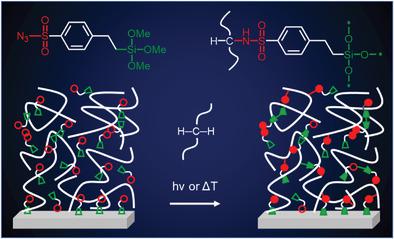当前位置:
X-MOL 学术
›
Macromol. Rapid Commun.
›
论文详情
Our official English website, www.x-mol.net, welcomes your feedback! (Note: you will need to create a separate account there.)
UV- and Thermally-Active Bifunctional Gelators Create Surface-Anchored Polymer Networks
Macromolecular Rapid Communications ( IF 4.6 ) Pub Date : 2021-06-26 , DOI: 10.1002/marc.202100266 Chinnayan Kannan Pandiyarajan 1 , Jan Genzer 2
Macromolecular Rapid Communications ( IF 4.6 ) Pub Date : 2021-06-26 , DOI: 10.1002/marc.202100266 Chinnayan Kannan Pandiyarajan 1 , Jan Genzer 2
Affiliation

|
A versatile one-step synthesis of surface-attached polymer networks using small bifunctional gelators (SBG), namely 4-azidosulfonylphenethyltrimethoxysilane (4-ASPTMS) and 6-azidosulfonylhexyltriethoxysilane (6-ASHTES) is reported. A thin layer (≈200 nm) of a mixture comprising ≈90% precursor polymer and 10% of 4-ASPTMS or 10% 6-ASHTES on a silicon wafer is deposited. Upon UV irradiation (≈l–254 nm) or annealing (>100 °C) layers, sulfonyl azides (SAz) release nitrogen by forming singlet and triplet nitrenes that concurrently react with any C─H bond in the vicinity resulting in sulfonamide crosslinks. Condensation among tri-alkoxy groups (i.e., methoxy or ethoxy) in bulk connects the SBG units, which completes the crosslinking. Concurrently, when such functionalities react with hydroxyl groups at the surface, which enable the covalent attachment of the crosslinked polymer chains. A systematic investigation on reaction mechanism and gel formation using spectroscopic ellipsometry (SE) and Fourier-transform infrared spectroscopy in the attenuated total reflection mode (FTIR-ATR) is performed. Analogous thermally initiated gelation for both 4-ASPTMS and 6-ASHTES is found. The 6-ASHTES is UV inactive at ≈l–254 nm, while the 4-ASPTMS is active and forms gels. The difference is attributed to the aromatic nature of 4-ASPTMS that absorb UV light at ≈l–254 nm due to π–π* transition.
中文翻译:

紫外线和热活性双功能凝胶剂创建表面锚定聚合物网络
报道了使用小型双功能凝胶剂 (SBG),即 4-叠氮磺酰基苯乙基三甲氧基硅烷 (4-ASPTMS) 和 6-叠氮磺酰基己基三乙氧基硅烷 (6-ASHTES) 进行表面附着聚合物网络的多功能一步合成。在硅晶片上沉积包含 ≈90% 前体聚合物和 10% 4-ASPTMS 或 10% 6-ASHTES 的混合物的薄层 (≈200 nm)。在紫外线照射 (≈l–254 nm) 或退火 (>100 °C) 层时,磺酰叠氮化物 (SAz) 通过形成单线态和三线态氮烯释放氮,这些氮烯同时与附近的任何 C─H 键反应,导致磺酰胺交联。本体中的三烷氧基(即甲氧基或乙氧基)之间的缩合连接SBG单元,从而完成交联。同时,当这些官能团与表面的羟基反应时,这使得交联的聚合物链能够共价连接。在衰减全反射模式 (FTIR-ATR) 中使用光谱椭偏仪 (SE) 和傅立叶变换红外光谱对反应机理和凝胶形成进行了系统研究。发现 4-ASPTMS 和 6-ASHTES 的类似热引发凝胶化。6-ASHTES 在 ≈l–254 nm 处不具有紫外线活性,而 4-ASPTMS 具有活性并形成凝胶。这种差异归因于 4-ASPTMS 的芳香性,由于 π–π 发现 4-ASPTMS 和 6-ASHTES 的类似热引发凝胶化。6-ASHTES 在 ≈l–254 nm 处不具有紫外线活性,而 4-ASPTMS 具有活性并形成凝胶。这种差异归因于 4-ASPTMS 的芳香性,由于 π–π 发现 4-ASPTMS 和 6-ASHTES 的类似热引发凝胶化。6-ASHTES 在 ≈l–254 nm 处不具有紫外线活性,而 4-ASPTMS 具有活性并形成凝胶。这种差异归因于 4-ASPTMS 的芳香性,由于 π–π*过渡。
更新日期:2021-08-20
中文翻译:

紫外线和热活性双功能凝胶剂创建表面锚定聚合物网络
报道了使用小型双功能凝胶剂 (SBG),即 4-叠氮磺酰基苯乙基三甲氧基硅烷 (4-ASPTMS) 和 6-叠氮磺酰基己基三乙氧基硅烷 (6-ASHTES) 进行表面附着聚合物网络的多功能一步合成。在硅晶片上沉积包含 ≈90% 前体聚合物和 10% 4-ASPTMS 或 10% 6-ASHTES 的混合物的薄层 (≈200 nm)。在紫外线照射 (≈l–254 nm) 或退火 (>100 °C) 层时,磺酰叠氮化物 (SAz) 通过形成单线态和三线态氮烯释放氮,这些氮烯同时与附近的任何 C─H 键反应,导致磺酰胺交联。本体中的三烷氧基(即甲氧基或乙氧基)之间的缩合连接SBG单元,从而完成交联。同时,当这些官能团与表面的羟基反应时,这使得交联的聚合物链能够共价连接。在衰减全反射模式 (FTIR-ATR) 中使用光谱椭偏仪 (SE) 和傅立叶变换红外光谱对反应机理和凝胶形成进行了系统研究。发现 4-ASPTMS 和 6-ASHTES 的类似热引发凝胶化。6-ASHTES 在 ≈l–254 nm 处不具有紫外线活性,而 4-ASPTMS 具有活性并形成凝胶。这种差异归因于 4-ASPTMS 的芳香性,由于 π–π 发现 4-ASPTMS 和 6-ASHTES 的类似热引发凝胶化。6-ASHTES 在 ≈l–254 nm 处不具有紫外线活性,而 4-ASPTMS 具有活性并形成凝胶。这种差异归因于 4-ASPTMS 的芳香性,由于 π–π 发现 4-ASPTMS 和 6-ASHTES 的类似热引发凝胶化。6-ASHTES 在 ≈l–254 nm 处不具有紫外线活性,而 4-ASPTMS 具有活性并形成凝胶。这种差异归因于 4-ASPTMS 的芳香性,由于 π–π*过渡。



























 京公网安备 11010802027423号
京公网安备 11010802027423号